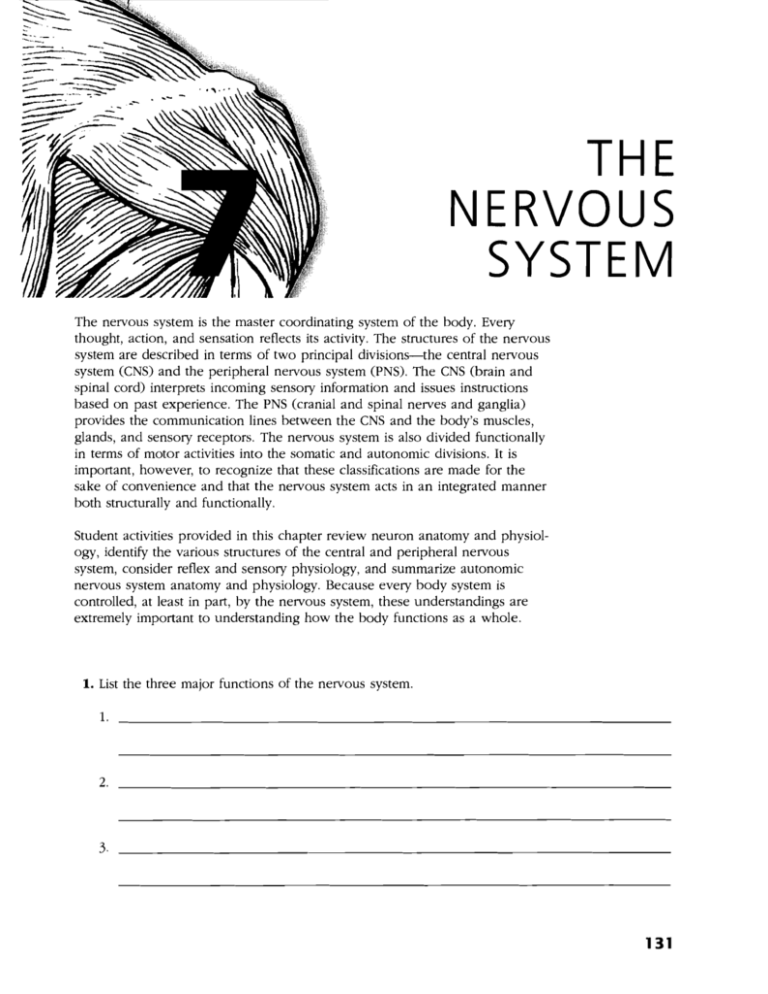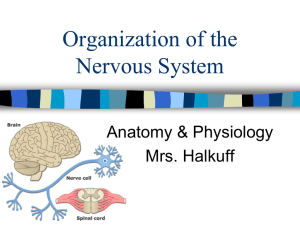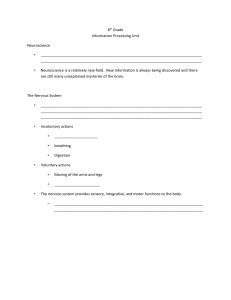THE NERVOUS SYSTEM
advertisement

THE NERVOUS SYSTEM The nervous system is the master coordinating system of the body. Every thought, action, and sensation reflects its activity. The structures of the nervous system are described in terms of two principal divisions-the central nervous system (CNS) and the peripheral nervous system (PNS). The CNS (brain and spinal cord) interprets incoming sensory information and issues instructions based on past experience. The PNS (cranial and spinal nerves and ganglia) provides the communication lines between the CNS and the body's muscles, glands, and sensory receptors. The nervous system is also divided functionally in terms of motor activities into the somatic and autonomic divisions. It is important, however, to recognize that these classifications are made for the sake of convenience and that the nervous system acts in an integrated manner both structurally and functionally. Student activities provided in this chapter review neuron anatomy and physiol­ ogy, identify the various structures of the central and peripheral nervous system, consider reflex and sensory physiology, and summarize autonomic nervous system anatomy and physiology. Because every body system is controlled, at least in part, by the nervous system, these understandings are extremely important to understanding how the body functions as a whole. 1. List the three major functions of the nervous system. 1. 2. 3. 131 132 Anatomy & Physiology Coloring workbook ORGANIZATION OF THE NERVOUS SYSTEM 2. Choose the key responses that best correspond to the descriptions provided in the following statements. Insert the appropriate letter or term in the answer blanks. Key Choices A. Autonomic nervous system C. Peripheral nervous system (PNS) B. Central nervous system (CNS) D. Somatic nervous system 1. Nervous system subdivision that is composed of the brain and spinal cord 2. Subdivision of the PNS that controls voluntary activities such as the activation of skeletal muscles 3. Nervous system subdivision that is composed of the cranial and spinal nerves and ganglia 4. Subdivision of the PNS that regulates the activity of the heart and smooth muscle, and of glands; it is also called the involuntary nervous system S. A major subdivision of the nervous system that interprets incoming information and issues orders 6. A major subdivision of the nervous system that serves as communication lines, linking all parts of the body to the CNS NERVOUS TISSUE-STRUCTURE AND FUNCTION 3. This exercise emphasizes the difference between neurons and neuroglia. Indicate which cell type is identified by the following descriptions. Insert the appropriate letter or term in the answer blanks. Key Choices A. Neurons B. Neuroglia 1. Support, insulate, and protect cells 2. Demonstrate irritability and conductivity, and thus transmit electrical messages from one area of the body to another area 3. Release neurotransmitters 4. Are amitotic S. Able to divide; therefore are responsible for most brain neoplasms Chapter 7 The Nervous System 4. Relative to neuron anatomy, match the anatomical terms given in Column B with the appropriate descriptions of functions provided in Column A. Place the correct term or letter response in the answer hlanks. Column A Column B 1. Releases neurotransmitters A. Axon 2. Conducts electrical currents B. Axon terminal toward the cell hody 3. Increases the speed of impulse transmission 4. Location of the nucleus C. Dendrite D. Myelin sheath E. Cell body 5. Generally conducts impulses away from the cell hody 5. Certain activities or sensations are listed helow. Using the key choices, select the specific receptor type that would he activated hy the activity or sensation described. Insert the correct term(s) or letter response(s) in the answer blanks. Note that more than one receptor type may he activated in some cases. Key Choices A. Bare nerve endings (pain) C. Meissner's corpuscle B. Golgi tendon organ D. Muscle spindle Activity or Sensation Receptor Type Walking on hot pavement 1. Odentify two) and Feeling a pinch 2. (Identify two) and Leaning on a shovel 3. Muscle sensations when rowing a boat 4. (Identify two) and Feeling a caress 5. E. Pacinian corpuscle 133 134 Anatomy & Physiology Coloring Workbook 6. Using the key choices, select the terms identified in the following descriptions by inserting the appropriate letter or term in the spaces provided. Key Choices A. Afferent neuron F. Neuroglia K. Proprioceptors B. Association neuron (or interneuron) G. Neurotransmitters 1. Schwann cells C. Cutaneous sense organs H. Nerve M. Synapse D. Efferent neuron I. Nodes of Ranvier N. Stimuli E. Ganglion J. Nuclei O. Tract 1. Sensory receptors found in the skin, which are specialized to detect temperature, pressure changes, and pain 2. Specialized cells that myelinate the fibers of neurons found in the PNS 3. Junction or point of close contact between neurons 4. Bundle of nerve processes inside the CNS 5. Neuron, serving as part of the conduction pathway between sensory and motor neurons 6. Gaps in a myelin sheath 7. Collection of nerve cell bodies found outside the CNS 8. Neuron that conducts impulses away from the CNS to muscles and glands 9. Sensory receptors found in muscle and tendons that detect their degree of stretch _ _ _ _ _ _ _ _ _ _ 10. Changes, occurring within or outside the body, that affect nervous system functioning _ _ _ _ _ _ _ _ _ _ 11. Neuron that conducts impulses toward the CNS from the body periphery ___________ 12. Chemicals released by neurons that stimulate other neurons, muscles, or glands Chapter 7 The Nervous System 7. Figure 7-1 is a diagram of a neuron. First, label the parts indicated on the illustration by leader lines. Then choose different colors for each of the structures listed below and use them to color in the coding circles and corresponding structures in the illustration. Next, circle the term in the list of three terms to the left of the diagram that best describes this neuron's structural class. Finally, draw arrows on the figure to indicate the direction of impulse transmission along the neuron's membrane. o o Axon Dendrites o Cell body o Myelin sheath Unipolar Bipolar Multipolar Figure 7-1 8. List in order the minimum elements in a reflex arc from the stimulus to the activity of the effector. Place your responses in the answer blanks. 1. Stimulus 4. 2. 5. Effector organ 3. 135 Chapter 7 The Nervous System 137 11. Refer to Figure 7-2, showing a reflex arc, as you complete this exercise. First, briefly answer the following questions by inserting your responses in the spaces provided. 1. What is the stimulus? 2. What tissue is the effector? _ 3. How many synapses occur in this reflex arc? Next, select different colors for each of the following structures and use them to color in the coding circles and corresponding structures in the diagram. Finally, draw arrows on the figure indicating the direction of impulse transmission through this reflex pathway. o o Receptor region Afferent neuron oEffector o o Interneuron Efferent neuron Figure 7-2 Chapter 7 The Nervous System 16. Figure 7-3 is a diagram of the right lateral view of the human brain. First, match the letters on the diagram with the following list of terms and insert the appropriate letters in the answer blanks. Then, select different colors for each of the areas of the brain provided with a color-coding circle and use them to color in the coding circles and corresponding structures in the diagram. If an identified area is part of a lobe, use the color you selected for the lobe but use stripes for that area. 1. 2. 3. 4. 0 0 0 0 Frontal lobe 7. Lateral sulcus Parietal lobe 8. Central sulcus Temporal lobe 9. 0 10·0 11. 0 12·0 Cerebellum Parieto-occipital fissure 5. 6. Precentral gyrus 0 Postcentral gyrus Medulla Occipital lobe Pons B ..-+-...,....--~...--_----=:~----c L ---~r__,"'------il:~­ K--~... J H----~~ G Figure 7-3 1 39 140 Anatomy & Physiology Coloring Workbook 17. Figure 7-4 is a diagram of the sagittal view of the human brain. First, match the letters on the diagram with the following list of terms and insert the appropriate letter in each answer blank. Then, color the brain-stem areas blue and the areas where cerebrospinal fluid is found yellow. 1. Cerebellum 9. Mammillary body 2. Cerebral aqueduct 10. Medulla oblongata 3. Cerebral hemisphere 11. Optic chiasma 4. Cerebral peduncle 12. Pineal body 5. Choroid plexus 13. Pituitary gland 6. Corpora quadrigemina 14. Pons 7. Corpus callosum 15. Thalamus 8. Fourth ventricle ABC J H G F Figure 7-4 Chapter 7 The NelVOUS System 141 18. Referring to the brain areas listed in Exercise 17, match the appropriate brain structures with the following descriptions. Insert the correct terms in the answer blanks. 1. Site of regulation of water balance and body temperature 2. Contains reflex centers involved in regulating respiratory rhythm in conjunction with lower brain-stem centers 3. Responsible for the regulation of posture and coordination of skeletal muscle movements 4. Important relay station for afferent fibers traveling to the sensory cortex for interpretation S. Contains autonomic centers, which regulate blood pressure and respiratory rhythm, as well as coughing and sneezing centers 6. Large fiber tract connecting the cerebral hemispheres 7. Connects the third and fourth ventricles 8. Encloses the third ventricle 9. Forms the cerebrospinal fluid _ _ _ _ _ _ _ _ _ _ 10. Midbrain area that is largely fiber tracts; bulges anteriorly ___________ 11. Part of the limbic system; contains centers for many drives (rage, pleasure, hunger, sex, etc.) 19. orne of the following brain structures consist of gray matter; others are hite matter. rite (for gray) or W(for ite) s appropriate. 1. uncle 4. Corpus callosum 144 Anatomy & Physiology Coloring Workbook Protection of the eNS 22. Identify the meningeal (or associated) structures described here. 1. Outermost covering of the brain, composed of tough fibrous connective tissue 2. Innermost covering of the brain; delicate and vascular 3. Structures that return cerebrospinal fluid to the venous blood in the dural sinuses 4. Middle meningeal layer; like a cobweb in structure 5. Its outer layer forms the periosteum of the skull 23. Figure 7-6 shows a frontal view of the meninges of the brain at the level of the superior sagittal (dural) sinus. First, label the arachnoid villi on the figure. Then, select different colors for each of the following structures and use them to color the coding circles and corresponding structures in the diagram. o o Dura mater Arachnoid mater Scalp o Pia mater o Subarachnoid space -+---~ Bone of skull Superior sagittal sinus Gray matter of cerebral cortex Figure 7-6 Chapter 7 The Nervous System 147 28. Figure 7-7 is a cross-sectional view of the spinal cord. First identify the areas listed in the key choices by inserting the correct letters next to the appropriate leader lines on parts A and B of the figure. Then, color the bones of the vertebral column in part B gold. Key Choices A. Central canal E. Dorsal root 1. Ventral horn B. Columns of white matter ' F. Dorsal root ganglion J. Ventral root C. Conus medullaris G. Filum terminale D. Dorsal horn H. Spinal nerve On part A, color the butterfly-shaped gray matter gray, and color the spinal nerves and roots yellow. Finally, select different colors to identify the following structures and use them to color the figure. o o Pia mater Dura mater o Arachnoid mater --.....~... ----~ ,....- A Figure 7-7 B Spinal cord Chapter 7 The Nervous System (~lknowledge: You have been given all of the information needed to identify the brain regions involved in the following situations. See how well your nervous system has integrated this information, and name the brain region (or condition) most likely to be involved in each situation. Place your responses in the answer blanks. 44. Application 1. Following a train al!'cident, a man with an obvious head injury was observed stumbling about the scene. An inability to walk properly and a loss of balance were quite obvious. What brain region was injured? 2. An elderly woman is admitted to the hospital to have a gallbladder operation. While she is being cared for, the nurse notices that she has trouble initiating movement and has a strange "pill-rolling" tremor of her hands. What cerebral area is most likely involved? 3. A child is brought to the hospital with a high temperature. The doctor states that the child's meninges are inflamed. What name is given to this condition? 4. A young woman is brought into the emergency room with extremely dilated pupils. Her friends state that she has overdosed on cocaine. What cranial nerve is stimulated by the drug? 5. A young man has just received serious burns, resulting from standing with his back too close to a bonfire. He is muttering that he never felt the pain. Otherwise, he would have smothered the flames by rolling on the ground. What part of his eNS might be malfunctioning? 6. An elderly gentleman has just suffered a stroke. He is able to understand verbal and written language, but when he tries to respond, his words are garbled. What cortical region has been damaged by the stroke? 7. A 12-year-old boy suddenly falls to the ground, having an epileptic seizure. He is rushed to the emergency room of the local hospital for medication. His follow-up care includes a recording of his brain waves to try to determine the area of the lesion. What is this procedure called? 1 57







